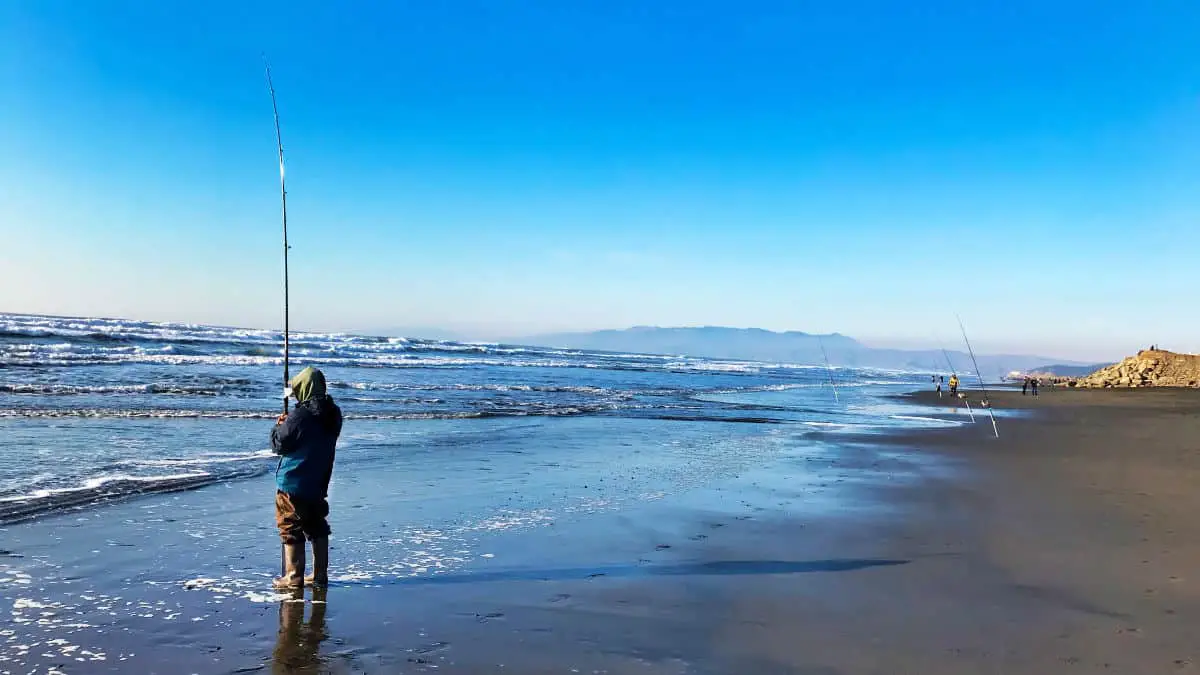You don’t need a boat or go to a pier to fish. With surf fishing, you wade out into the shore and cast your line. But, there’s a lot of things you need to consider before you start throwing your line.
As new to surf fishing, I would like to know the rules and regulations that need to follow, and what are the essential equipment for these sports.
After reading a countless of articles online. I breakdown all the things that you need to keep in mind before you start to surf fishing. Check out my surf fishing guide and tips for beginners.
Research the Rules and Regulations in Your Area
The specific rules and regulations for surf fishing are varied with each county, state, and country. When I first moved to California, I found that I needed a California Fishing License when fishing from the surf or a boat, but no fishing license is required when fishing from a pier.
are varied with each county, state, and country. When I first moved to California, I found that I needed a California Fishing License when fishing from the surf or a boat, but no fishing license is required when fishing from a pier.
In some parts of California, you also need to get an Ocean Enhancement Stamp. This applies to all areas south of Santa Barbara County.
Does a Fishing License Require When Surf Fishing?
The first step in mastering the art of surf fishing is obtaining your fishing license. In California, any person 16-years or older needs a valid sports fishing license when surf fishing for any fish, reptile, shellfish, or amphibian. This is a pretty standard requirement.
when surf fishing for any fish, reptile, shellfish, or amphibian. This is a pretty standard requirement.
Most states require a fishing license for shore fishing. Depending on the local regulations, you may need an additional stamp to bag certain types of fish.
States also tend to place limits on the number and types of fish that you can bag. These limits may change throughout the seasons or based on the estimated population of the specific species.
The number of rods you can use and where you can fish also vary, making it essential that you check out the rules in your area.
If you get caught violating any of the regulations , you could face hefty fines. Misdemeanors can cost $100 to $1,000 in California while repeat violations may result in jail time.
, you could face hefty fines. Misdemeanors can cost $100 to $1,000 in California while repeat violations may result in jail time.
How to Find the Fishing Regulations in Your State
Each state typically controls their own fishing regulations, but some counties may impose their additional restrictions on top of the state laws.
If you want to learn the regulations in your region, you should first determine the name of the agency responsible for controlling wildlife laws in your state.
The California Department of Fish and Wildlife (CDWF)  manages sports fishing in California. Instead of “fish and wildlife,” some agencies are responsible for “fish and game” or “wildlife conservation.”
manages sports fishing in California. Instead of “fish and wildlife,” some agencies are responsible for “fish and game” or “wildlife conservation.”
The Department of Natural Resources handles fishing licenses and laws in Illinois, Maryland, Michigan, and several other states.
Where Can You Purchase a Fishing License?
You can typically purchase fishing licenses at any of your state’s wildlife agencies and through licensed agents.
Again, you’ll need to check with your local agency for specific details, but most bait shops and sporting goods stores are permitted to sell licenses.
for specific details, but most bait shops and sporting goods stores are permitted to sell licenses.
In every state that I’ve checked, the licenses are valid for one calendar year. A calendar year is January 1st through December 31st. If you purchase your license in April, it still expires at the end of the year.
Safety Always Comes First
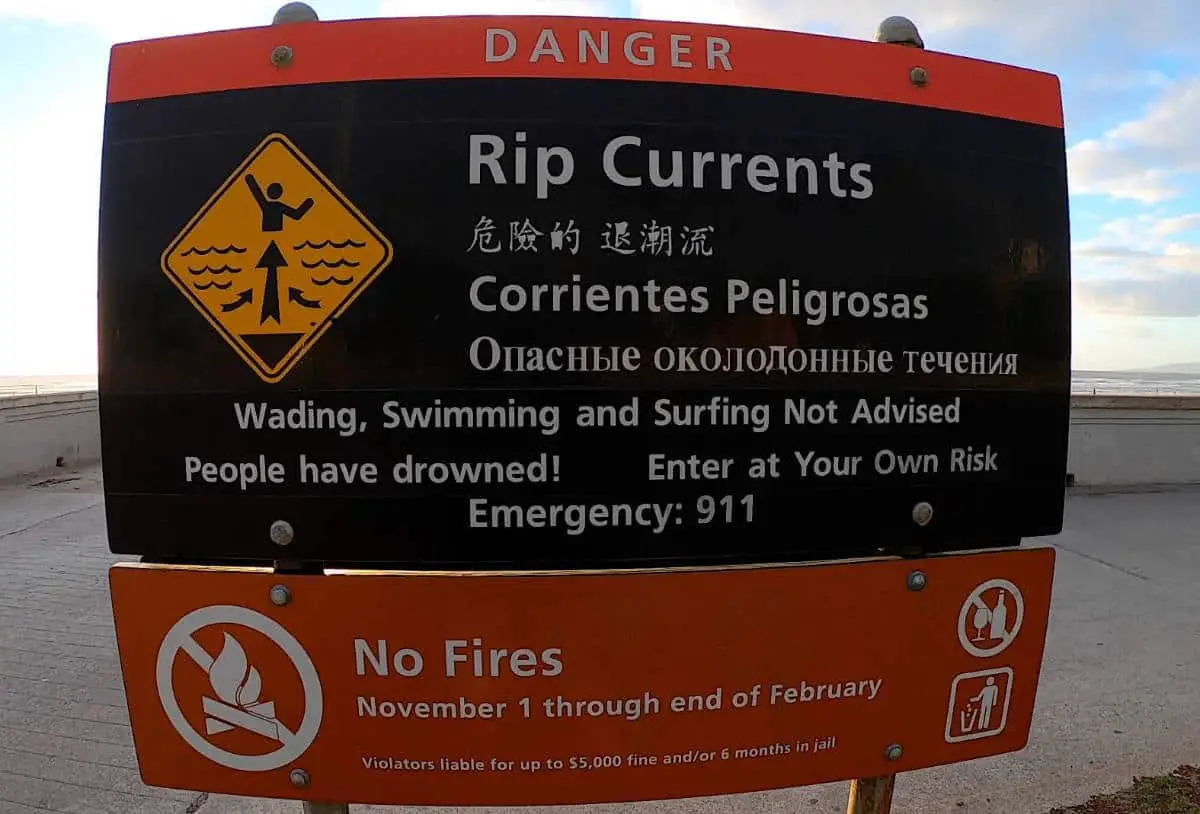
After you’ve purchased your fishing license and researched your local regulations, you’re almost ready to wade into the shore. Your next task is to understand the safety precautions.
Standing in water isn’t necessarily the safest way to fish. There are many hazards to watch out for, including:
- Jellyfish
- Sharks
- Storms
- Tidal currents
- Riptides
- Surfers
- Beachgoers
- Jet skis and motorboats
- Other anglers
Always pay attention to your surroundings when surf fishing. Watch the water for a minute before you start wading in. Always keep an eye on a sneakers wave and never turn your back to the ocean. If you want to learn more about sneakers wave check it out here.
Always Check the Weather and Current Conditions
Also, consider checking the weather forecast and current conditions before heading out to the beach. Don’t go fishing during a thunderstorm or severe weather.
before heading out to the beach. Don’t go fishing during a thunderstorm or severe weather.
If the forecast looks good, you should still check the current conditions when you arrive at the ocean. Look for any beach warning flags that may indicate a potential threat.
A red flag typically indicates a severe weather hazard. Blue and purple flags let beach-goers know that sharks or jellyfish have spotted in the area.
Consider Checking the Tide, Times and Charts
Besides checking the general weather forecast, you should also consider checking the tide forecast. You can find local tide times and charts to determine when to expect low tide and high tide.
You may not want to head out when the tide is so high. Extreme swell is dangerous, and sometimes it’s not worth the trip.
It’s also important to let your relatives or friends know where you’re going to fish and when you’re planning on returning.
Surf Fishing Equipment for Beginners
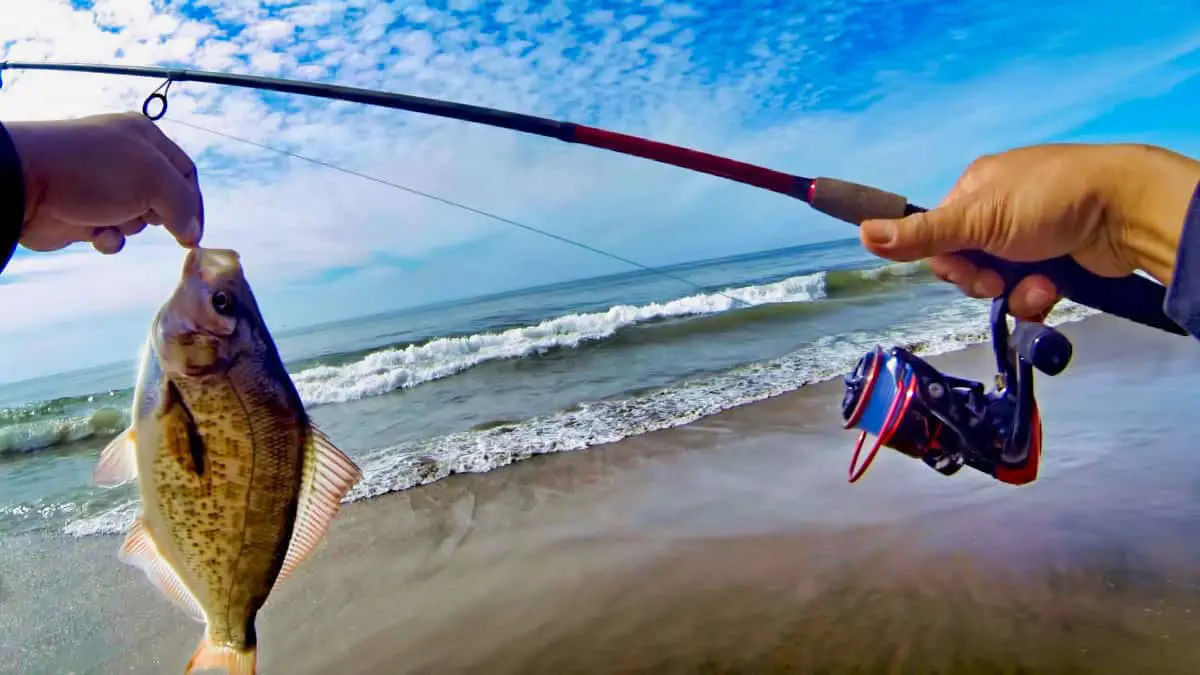
You’ll need to gather a few essential pieces of fishing gear before you start fishing. Your tackle is your collection of hooks, rods, reels, lures, nets, and everything else.
Beginners often make the mistake of buying everything they think they’ll need and end up with a lot of stuff they’ll never use. Buy the essential items and learn the ropes.
You’ll discover what works best for you and then you can begin building your tackle box.
Saltwater Spinning Rod
Your rod and reel
and reel are the first two items that you’ll need to get, but you don’t need to rush out and buy a top-of-the-line rod and reel. The main details to consider when choosing a spinning rod for beginners
are the first two items that you’ll need to get, but you don’t need to rush out and buy a top-of-the-line rod and reel. The main details to consider when choosing a spinning rod for beginners include:
include:
- Rod length
- Rod power
- Rod action
- Reel seats
- Handles
Most surf rods  are between 7 and 11-feet long. However, I would suggest that you go with a rod that fits your needs.
are between 7 and 11-feet long. However, I would suggest that you go with a rod that fits your needs.
A longer rod allows you to cast further, but you still need to control the rod, so choose the right length for your height.
The rod power is the lifting power of the rod. A medium-heavy rod is the most popular option for beginners, as it provides the most versatility.
The rod action refers to the bend of the rod. With a fast action rod, the rod bends closer to the tip. A slow action rod bends near the middle. A faster tip helps you get a more extended cast.
High-end rods often feature graphite reel seats, which don’t corrode like other options.
For your first rod, a metal alloy reel seat should suffice. The handles are typically either foam or cork. Cork may last a little longer, but either option is excellent.
Saltwater Spinning Reel
Spinning reels are the most versatile type of reel, which makes them the right choice for beginners. They are also easier for surf fishing in my own opinion, as they make it easier to cast your line.
are the most versatile type of reel, which makes them the right choice for beginners. They are also easier for surf fishing in my own opinion, as they make it easier to cast your line.
When shopping for reels, it’s important to look at the reel sizes. The rating is based on the maximum kilogram of fish that it can support. It also corresponds to the weight of the line that you should use.
Class 10 to 35 reels are for reeling in smaller fish weighing up to 10 pounds. For lighter reels, I recommend a 14-pound line.
The medium-sized reels are class 40 to 55. They can catch larger fish weighing up to 14 pounds and work with 25-pound line.
The class 60 to 95 reels are the heavy reels for surf fishing. They typically pair well with 30-pound line, which brings us to our next piece of equipment.
Surf Fishing Line
The main types of fishing lines include braided line
include braided line , monofilament, and fluorocarbon.
, monofilament, and fluorocarbon.
Braided line offers minimal stretch. It works best with spinning reels
offers minimal stretch. It works best with spinning reels and cuts through the water quickly, making it easier to cast further.
and cuts through the water quickly, making it easier to cast further.
Fluorocarbon is thin, versatile, and abrasion-resistant. It also offers the most stretch and sinks the fastest.
is thin, versatile, and abrasion-resistant. It also offers the most stretch and sinks the fastest.
Monofilament offers a little more stretch and a larger diameter and less expensive compared to fluorocarbon.
Braided line is my preferred for surf fishing, well suited for casting while the thin, durable fluorocarbon is perfect for a leader.
Hooks, Leader, and Sinkers
The hooks, leaders, and sinkers that you use are also important to your rig. If you’re new to fishing, you probably know what a hook is, but may not know what to do with a leader or a sinker. I’ll personally use two kinds of hooks, Circle hooks, and J-hooks, but you can use any hook of your choice.
Bait-holder J-Hooks
Baitholder J hook has two barbs along the back of the shank. It allows you to lock your bait securely in place. However, not like the circle hook, this one requires a hook set. This hook is also great for perch fishing or either striped bass.
Circle Hooks
The circle hook is the best option for catch and release. It doesn’t require a hook set, as long as you remove the slack and keep the tension of your line.
The curve keeps the hook from getting lodged in the back of the fish’s throat. As the fish swims away, the hook slides forward and gets them in the front part of the mouth.
What is the Best Knot for a Circle Hook?
The best knot is the snell knot. It keeps your line and hooks in a straight line, and it gives you a better hook up ratio.
How to Tie a Snell Knot Video
What is a Leader?
A leader is a short length of fluorocarbon or monofilament used to tie your rig and connect it to your mainline. It also absorbs the shock when you cast the lure.
is a short length of fluorocarbon or monofilament used to tie your rig and connect it to your mainline. It also absorbs the shock when you cast the lure.
They also give abrasion resistance when the fish are rubbing against the rock.
Another essential reason why use a leader is when you handle the fish, you need something thick to grab on instead of grabbing the braided line. It prevents you from getting cut in hand.
Sinkers
You don’t need a wide variety of weights. Start with two, three, and four-ounce sinkers. You should also try a few different shapes to find out what style you prefer.
to find out what style you prefer.
A sinker is a weight that helps you cast further and allow your hooks to drop below the surface.
They’re an essential part of your rig and come in a variety of sizes and shapes. Typically, you’ll want a heavier sinker for dealing with stronger waves and lighter weight for calm waters.
Surf Fishing Rigs for Beginners
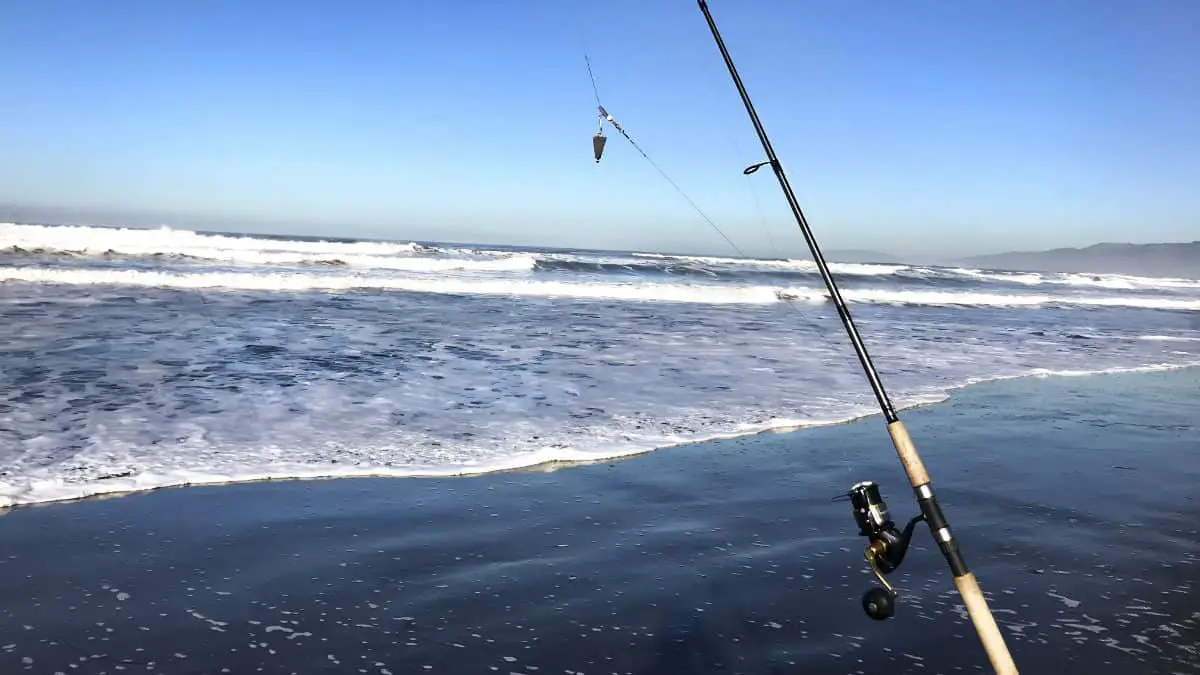
Your rig is your combination of hook, line, sinkers, and bait. You need to tailor it to the waters and species that you plan to fish.
Choosing the right fishing rig can make a big difference in your success. The fish-finder rig and high-low rig are two of the most versatile and useful fishing rigs for beginners.
The Fish Finder Rig
The fish-finder rig is my preferred setup. You’ll need several items to put this rig together:
- 20 – 40-pound test fluorocarbon leader
- Plastic Bead
- Circle hook or J-hook
- Barrel swivel
- Sinker-slider
- 2-3 oz Sinker
How to Set-up Fish Finder Rig?
Slide the sinker-slider followed by the plastic bead onto the mainline. Using the knot of your choice tie the mainline to the barrel swivel.
Grab your desired length of a leader with a hook, and tie it at the other end of the barrel swivel. Your sinker should be attached to the snap swivel of the sinker slider.
The good thing of using a slider is you can adjust the weight anytime depending on the current.
Hi-Low Rig
This rig allows you to doubles your chances. You can use two hooks in one leader and allow you to use two different baits at the same time, and occasionally double the fish you catch.
To set up this rig you’ll need the following:
- 20 – 40-pound test fluorocarbon leader
- Two circle hooks or J-hooks
- 2-3 oz Sinker
The sinker is added at the end of the leader, below the hooks, instead of above the hooks. You then use dropper loops to add the hooks.
Live Baits and Artificial Lures
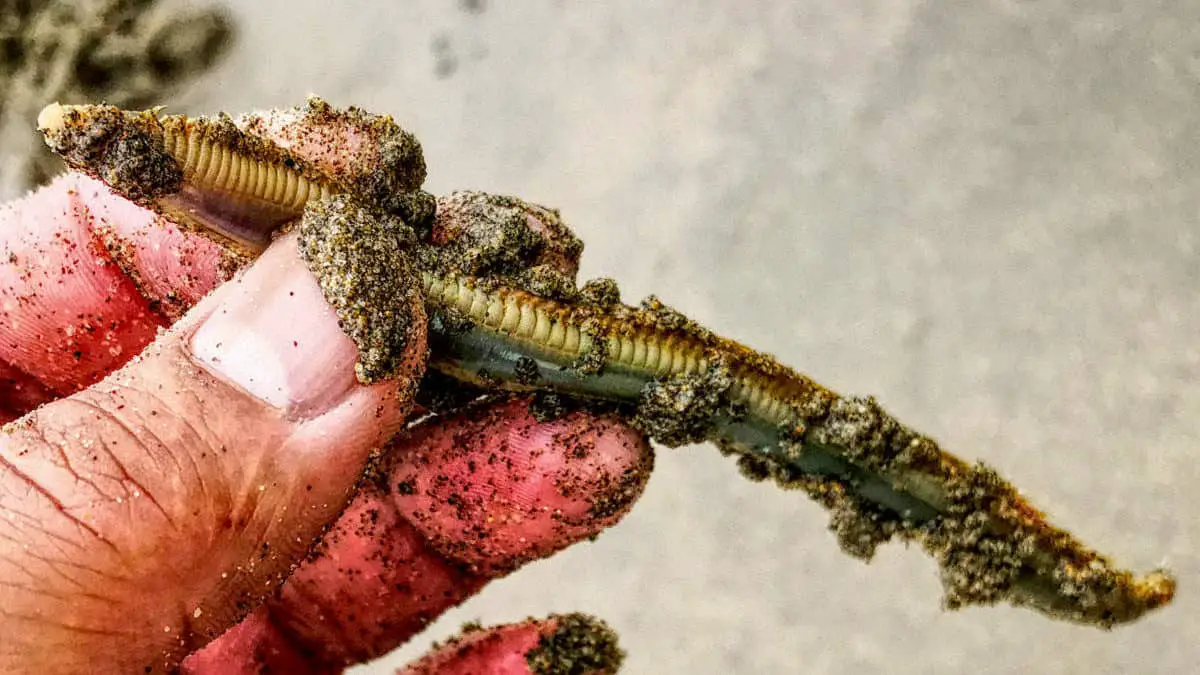
Lures and live bait are how you attract the fish. It’s a simple concept, yet there are thousands of options and an equal number of personal opinions on the subject. Here are my recommendations for luring fish to your hook
Softshell Sand Crabs
Softshell sand crabs are my top choice for catching surf fish in Northern California . I’ve had a lot of success catching Barred Perch, Red Tail Perch, and Striped Bass using this bait. You can find them all along the coast, especially in April when they start spawning.
. I’ve had a lot of success catching Barred Perch, Red Tail Perch, and Striped Bass using this bait. You can find them all along the coast, especially in April when they start spawning.
How to Catch Softshell Sandcrabs
I usually look for small clusters of the crabs lightly buried under the sand. Using my hand or sand crabs net, I wait for the wave to recedes I scoop them up and use them throughout the day.
How to Identify Softshell Sandcrabs?
Softshell sand crab has a translucent color and also a softback when you squeeze it — great baits for perch fishing and striped bass.
Sandworms
You can try to find sandworms or buy them fresh at a local bait shop. Finding sandworms isn’t always easy, and I’d typically instead buy a handful before fishing, as they’re not very expensive.
You’re also less likely to get bitten by the worm if you don’t need to dig for them. When fishing for Striped bass, Barred Surf Perch or other large species, sandworm is another option.
After buying or finding your bait, store your sandworms in a covered box and away from sunlight. Don’t get them out until you’re ready to use them.
Artificial Lures for Surf Fishing
Some anglers prefer to use live bait while others only use artificial lures. The truth is that the best option depends on the fish. With the right lure, it’s easier to attract certain species.
To find the best lures, you should learn more about the  different types of lures, including bucktail jig, plastic lures,
different types of lures, including bucktail jig, plastic lures,
Metal spoons are also great for surf fishing. Most of these lures are designed to resemble baitfish and come in bright, shiny, metal colors. All these lures have a different procedure of retrieval.
Choosing The Right Clothing for Surf Fishing
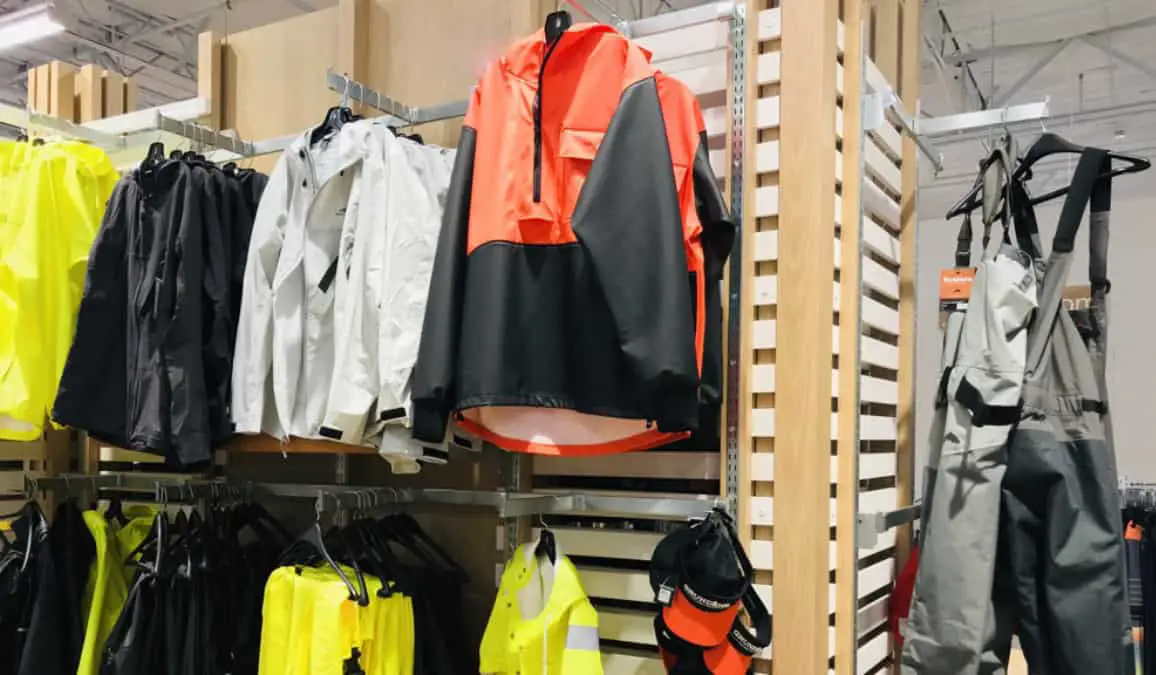
You may not want to go surf fishing in your typical attire. Wading into the water in your shorts and sneakers is not the best idea. Here are the principal articles of clothing and clothing accessories that you should consider wearing.
in your typical attire. Wading into the water in your shorts and sneakers is not the best idea. Here are the principal articles of clothing and clothing accessories that you should consider wearing.
Waders keep you from getting soaked while standing in the water. They are like rain boots that can extend up to your hip, waist, chest. They also come in a variety of sizes, materials, and styles.
keep you from getting soaked while standing in the water. They are like rain boots that can extend up to your hip, waist, chest. They also come in a variety of sizes, materials, and styles.
Breathable Waders
PVC and nylon waders tend to be less costly but wear out fast. While breathable waders are the most expensive option, they’re my preferred choice. Breathable waders  allow you to perspire without letting you get wet, keeping dry, cool, and comfortable.
allow you to perspire without letting you get wet, keeping dry, cool, and comfortable.
Neoprene Waders
If quality breathable waders are out of your price range, I suggest you search for neoprene waders. They are heavier, more durable, and should last longer compared to PVC or nylon. Keep in mind that these waders don’t offer the same comfort offered with breathable waders.
Stocking foot Vs. Boot foot waders
The advantage of boot foot waders is, it comes with wading boots and ready to put on. You don’t need to spend an extra dollar for the wading boots.
Stockingfoot waders are lighter and more comfortable to walk on the beach. But you need to buy wading boots or any footwear you prefer. I paired mine with Shimano wading shoes and I never more happy with it.
are lighter and more comfortable to walk on the beach. But you need to buy wading boots or any footwear you prefer. I paired mine with Shimano wading shoes and I never more happy with it.
Either stocking foot waders or boot foot will do the job of keeping you dry. Also always consider wearing wading socks to keep your feet warmer. I will recommend choosing whatever makes you comfortable and suits your needs.
Neoprene vs Breathable Waders Video
Surf Fishing Jacket
While your legs are secure with waders, your arms still need cover. Wearing a surf fishing jacket helps you stay warm when surf fishing in the chilly morning or evening air. You can also easily remove your top if you get too warm.
when surf fishing in the chilly morning or evening air. You can also easily remove your top if you get too warm.
Surf Fishing Belt
A surf fishing belt is an essential piece of equipment. It keeps water from flooding your waders if you wade too far. It provides the perfect spot to hang or clip your most essential tools.
Make sure that you get an adjustable belt so that you can get a tight fit. I also like using a belt with hooks for carabiner clips for securing items, such as my pliers.
Recommended Tools, Equipment and Accessories
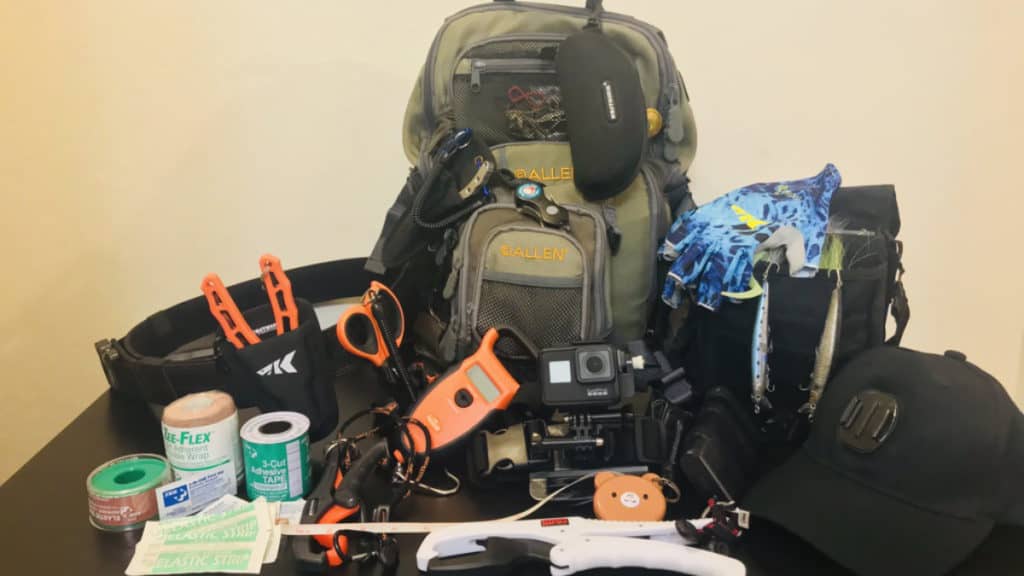
It’s easy to focus on a tackle when putting together your surf fishing gear. While you need bait and lures, there is plenty of other fishing equipment and accessories that you need.
Fishing Backpack
The first thing you need is something to hold your stuff. I prefer a large  fishing backpack with a lot of different compartments. It’s a little easier to carry compared to a standard tackle box and keeps your hands free for your bucket and pole.
fishing backpack with a lot of different compartments. It’s a little easier to carry compared to a standard tackle box and keeps your hands free for your bucket and pole.
When choosing a backpack , look for a bag that includes padded, adjustable shoulder straps. Adjusting the straps to your body size helps increase the comfort and reduce back strain.
, look for a bag that includes padded, adjustable shoulder straps. Adjusting the straps to your body size helps increase the comfort and reduce back strain.
Fishing Pliers
Pliers are necessary tools for surf fishing. You can use them for cutting your line or removing hooks from fish. When shopping for fishing pliers, search for aluminum pliers. Unlike steel pliers, aluminum pliers won’t rust, and they come with durable carbide steel cutters.
Measuring Tape or Ruler
A measuring tape is an easy accessory to overlook, but it may help save you from expensive fines. Some states include limits on the size of the fish. If it’s too small or big, you may need to release it or pay a fine. You can also use your measuring tape to keep track of your catches.
Digital Scale
Besides the length of the fish, some states place restrictions on the weight of the fish. It’s also fun to keep track of the length and weight of your catches.
With a digital scale, you can quickly weigh your fish and toss them in your bucket or back into the waters.
Fish Lip Grippers
Fish lip grippers are useful tools for helping you land and handle fish that put up a fight. Grippers are a little more comfortable to use compared to a net, as you don’t need to worry about the hook getting caught.
They also take up less space. I recommend the plastic fish grippers, as they’re lightweight and can float in the water if you happen to drop them.
Fishing Line Cutter or Scissors
While pliers help you cut your fishing line, you need scissors to do the cutting. Get a small pair of scissors with sharp blades.
They take up hardly any space and are incredibly useful. Besides cutting line, you may need them to cut through the fabric after getting hooked.
Sand Crabs Net
Use to catch sand crabs. Softshell sand crabs are great for live bait. These small crustaceans are the preferred food of many surf fish, including perch and striped bass.
Waist Live Baits Storage Box
Instead of storing your live bait in a hard-to-reach spot, you can keep them at your waist. A waist live storage box straps around your waist and includes a secure place for storing bait. They typically feature adjustable waist straps and a sealable lid to help keep your bait fresh.
Sand Spike
Whether you make your own sand spike or purchase one, they are useful tools for keeping your second rod from getting swept away. You can also use it to secure your rod while cutting the line or taking a short break.
Digital Camera
A digital camera allows you to immortalize your surf fishing achievements, which is especially significant when your catching and releasing.
allows you to immortalize your surf fishing achievements, which is especially significant when your catching and releasing.
You can record your prized moments and share them with your friends, family, and coworkers.
The GoPro is the go-to camera for outdoor recording. They are waterproof and designed for recording action shots, such as casting your line or reeling in a big one. You can also use your phone if GoPro is out of your range.
First Aid Kit
As mentioned, safety comes first. Checking the weather and paying attention to your surroundings is just the start. You should also bring a first aid kit for unexpected emergencies.
The most common surf fishing injury is a hook to the face or the back of the neck a cut to your finger. If you remember the earlier tip and always pay attention to your surroundings, you may not need a first aid kit. It’s better to be safe and pack a kit that includes the standard items, such as:
- Gauze pads
- Adhesive bandages
- Antibiotic cream
- Pain killers
You may also want to add a bottle of vinegar to your kit. If you happen to get stung by a jellyfish, you can rinse the site of the sting with vinegar to help stop the stinging.
Hats, Sunglasses, and Face Shield
You may spend hours under the sun when surf fishing. Protect your face with a sunblock, wide-brimmed hat and sunglasses. If you leave your face exposed, you risk getting burnt.
Along with the hat and sunglasses, I recommend getting a face shield for windy days. You can cover your entire face with these cloth shields, protecting yourself from the sun and wind.
Summary
Why spend money on a boat when you can fish from the shore? Surf fishing is the perfect way to enjoy one of the best outdoor activities. You can wade out into the water, cast your line, and have fun. This guide covers the essential tips for getting started with surf fishing, from figuring out the fishing regulations in your area to choosing the right equipment.

